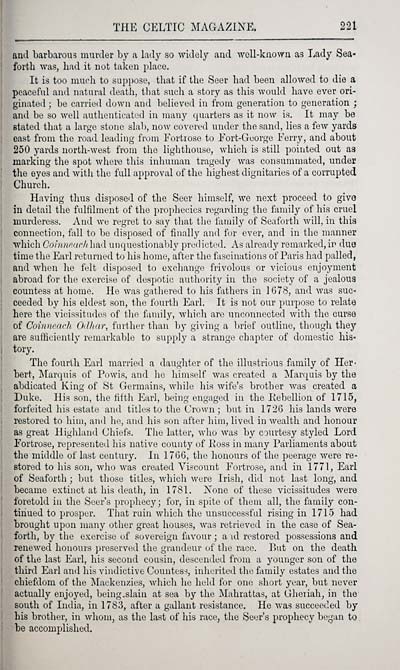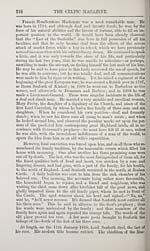Blair Collection > Celtic magazine > Volume 2
(231)
Download files
Complete book:
Individual page:
Thumbnail gallery: Grid view | List view

THE CELTIC MAGAZIKE. 221
and barbarous murder by a lady so widely and well-known as Lady Sea-
forth was, bad it not taken place.
It is too niucb to suppose, that if the Seer liad been allowed to die a
peaceful and natural death, that such a story as this would have ever ori-
ginated ; be carried down and believed in from generation to generation ;
and be so well authenticated in many cpiarters as it now is. It may be
stated that a large stone slab, now covered under the sand, lies a few yards
east from the road leading from Fortiose to Fort-George Ferry, and about
250 yards north-west from the lighthouse, which is still pointed out as
marking the spot where this iuluiman tragedy was consummated, under
the eyes and with the full approval of the highest dignitaries of a corrupted
Church.
Having thus disposed of the Seer himself, we next proceed to give
in detail the fulfilment of the prophecies regarding the family of his cruel
murderess. And we regret to say that the family of Seafortli will, in this
connection, fall to be disposed of finally and for ever, and in the manner
which Coiniimc/i had unquestionalily predicted. As already remarked, ir due
time the Earl returned to his home, after the fascinations of Paris had palled,
and when he felt disposed to exchange frivolous or vicious enjoyment
abroad for the exercise of despotic authority in the society of a jealous
countess at home. He was gathered to his fathers in 1 678, and was sue--
ceeded by his eldest son, the fourth Earl. It is not our purpose to relate
here the vicissitudes of tlie faniily, which are unconnected with tlie curse
of Coinneach Odhar, further than Ijy giving a In'ief outline, though they
are sufficiently remarkable to supply a strange chapter of domestic his-
tory.
The fourth Earl married a daughter of the illustrious family of Her-
bert, ]\Iarquis of Powis, and he himself was created a Marquis by the
abdicated King of St Germains, wliile his wife's brother was created a
Duke. His son, the fifth Earl, being engaged in the Eebellion of 1715,
forfeited his estate and titles to the Crown; but in 1726 his lands were
restored to him, and he, and his son after him, lived in wealth and honour
as great Highland Chiefs. The latter, who was by courtesy styled Lord
Fortrose, represented his native county of Ross in many Parliaments about
the middle of last century. In 1766, the honours of the peerage were re-
stored to his son, who Avas created Viscount Fortrose, and in 1771, Earl
of Seaforth ; but those titles, which were Irish, did not last long, and
became extinct at his death, in 1781. I^one of these vicissitudes were
foretold in the Seer's prophecy; for, in spite of them all, the family con-
tinued to prosper. That ruin whicli the unsuccessful rising in 1715 had
brought upon many other great houses, was retrieved in the case of Sea-
forth, by the exercise of sovereign favour ; a \d restored possessions and
renewed honours preserved the grandeur of the race. But on the death,
of the last Earl, his second cousin, descended from a younger son of the
third Earl and his vindictive Countess, inherited the family estates and the
chiefdom of the INIackenzies, whicli he held for one short year, but never
actually enjoyed, being. slain at sea by the Mahrattas, at Gheiiah, in the
south of Intlia, in 1783, after a gallant resistance. He Avas succeeded by
his brother, iu whom, as the last of his race, the Seer's prophecy began to
be accomplished.
and barbarous murder by a lady so widely and well-known as Lady Sea-
forth was, bad it not taken place.
It is too niucb to suppose, that if the Seer liad been allowed to die a
peaceful and natural death, that such a story as this would have ever ori-
ginated ; be carried down and believed in from generation to generation ;
and be so well authenticated in many cpiarters as it now is. It may be
stated that a large stone slab, now covered under the sand, lies a few yards
east from the road leading from Fortiose to Fort-George Ferry, and about
250 yards north-west from the lighthouse, which is still pointed out as
marking the spot where this iuluiman tragedy was consummated, under
the eyes and with the full approval of the highest dignitaries of a corrupted
Church.
Having thus disposed of the Seer himself, we next proceed to give
in detail the fulfilment of the prophecies regarding the family of his cruel
murderess. And we regret to say that the family of Seafortli will, in this
connection, fall to be disposed of finally and for ever, and in the manner
which Coiniimc/i had unquestionalily predicted. As already remarked, ir due
time the Earl returned to his home, after the fascinations of Paris had palled,
and when he felt disposed to exchange frivolous or vicious enjoyment
abroad for the exercise of despotic authority in the society of a jealous
countess at home. He was gathered to his fathers in 1 678, and was sue--
ceeded by his eldest son, the fourth Earl. It is not our purpose to relate
here the vicissitudes of tlie faniily, which are unconnected with tlie curse
of Coinneach Odhar, further than Ijy giving a In'ief outline, though they
are sufficiently remarkable to supply a strange chapter of domestic his-
tory.
The fourth Earl married a daughter of the illustrious family of Her-
bert, ]\Iarquis of Powis, and he himself was created a Marquis by the
abdicated King of St Germains, wliile his wife's brother was created a
Duke. His son, the fifth Earl, being engaged in the Eebellion of 1715,
forfeited his estate and titles to the Crown; but in 1726 his lands were
restored to him, and he, and his son after him, lived in wealth and honour
as great Highland Chiefs. The latter, who was by courtesy styled Lord
Fortrose, represented his native county of Ross in many Parliaments about
the middle of last century. In 1766, the honours of the peerage were re-
stored to his son, who Avas created Viscount Fortrose, and in 1771, Earl
of Seaforth ; but those titles, which were Irish, did not last long, and
became extinct at his death, in 1781. I^one of these vicissitudes were
foretold in the Seer's prophecy; for, in spite of them all, the family con-
tinued to prosper. That ruin whicli the unsuccessful rising in 1715 had
brought upon many other great houses, was retrieved in the case of Sea-
forth, by the exercise of sovereign favour ; a \d restored possessions and
renewed honours preserved the grandeur of the race. But on the death,
of the last Earl, his second cousin, descended from a younger son of the
third Earl and his vindictive Countess, inherited the family estates and the
chiefdom of the INIackenzies, whicli he held for one short year, but never
actually enjoyed, being. slain at sea by the Mahrattas, at Gheiiah, in the
south of Intlia, in 1783, after a gallant resistance. He Avas succeeded by
his brother, iu whom, as the last of his race, the Seer's prophecy began to
be accomplished.
Set display mode to: Large image | Transcription
Images and transcriptions on this page, including medium image downloads, may be used under the Creative Commons Attribution 4.0 International Licence unless otherwise stated. ![]()
| Early Gaelic Book Collections > Blair Collection > Celtic magazine > Volume 2 > (231) |
|---|
| Permanent URL | https://digital.nls.uk/78482926 |
|---|
| Description | Volume II, 1877. |
|---|---|
| Shelfmark | Blair.3 |
| Attribution and copyright: |
|
| Description | A selection of books from a collection of more than 500 titles, mostly on religious and literary topics. Also includes some material dealing with other Celtic languages and societies. Collection created towards the end of the 19th century by Lady Evelyn Stewart Murray. |
|---|
| Description | Selected items from five 'Special and Named Printed Collections'. Includes books in Gaelic and other Celtic languages, works about the Gaels, their languages, literature, culture and history. |
|---|

